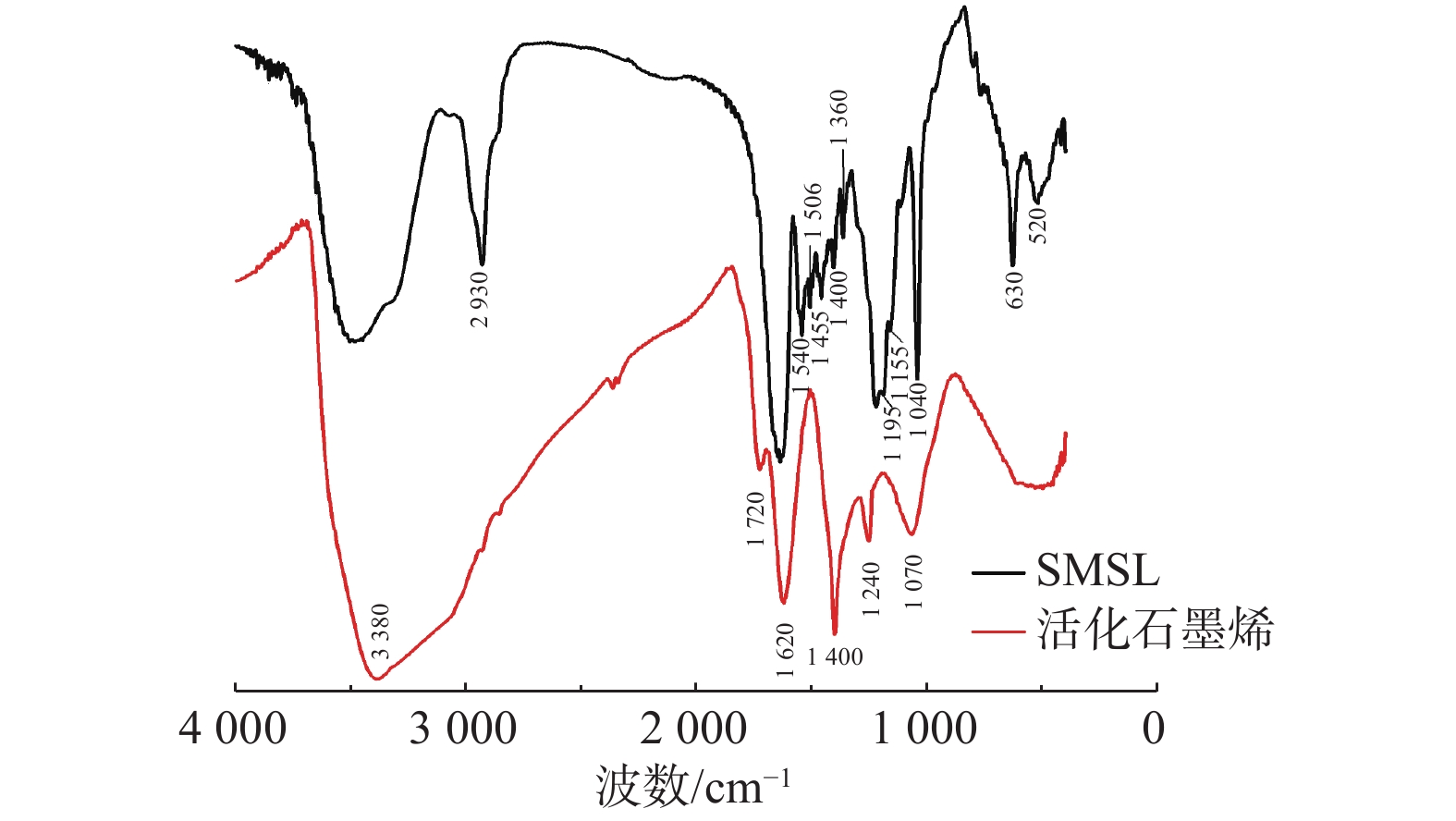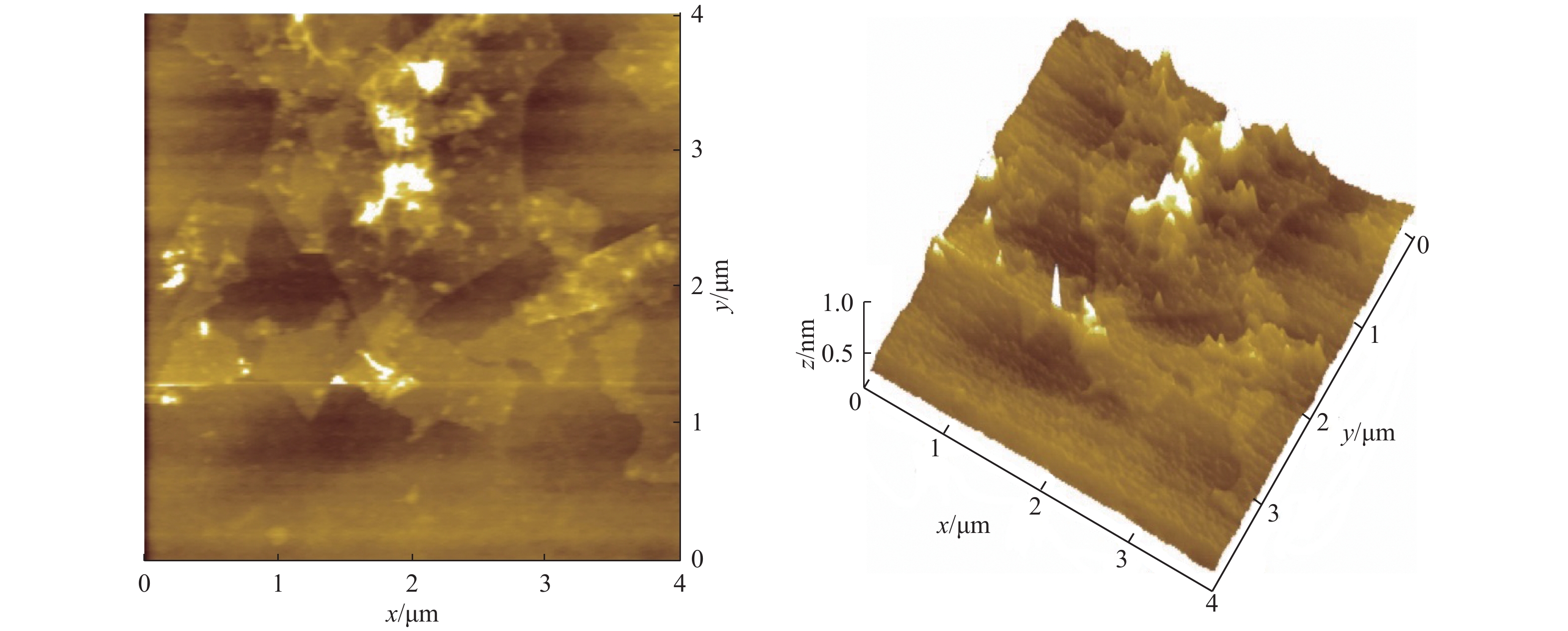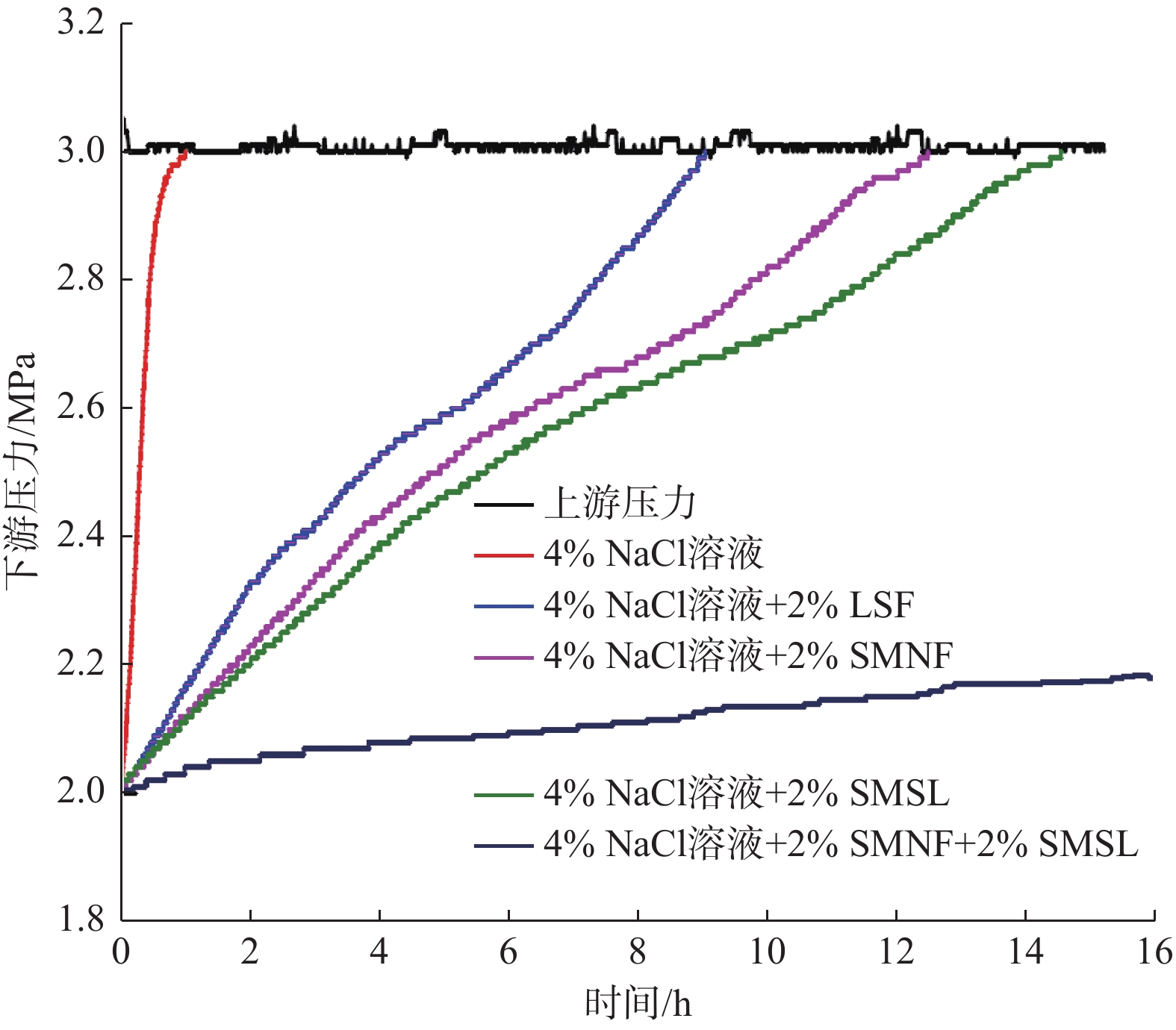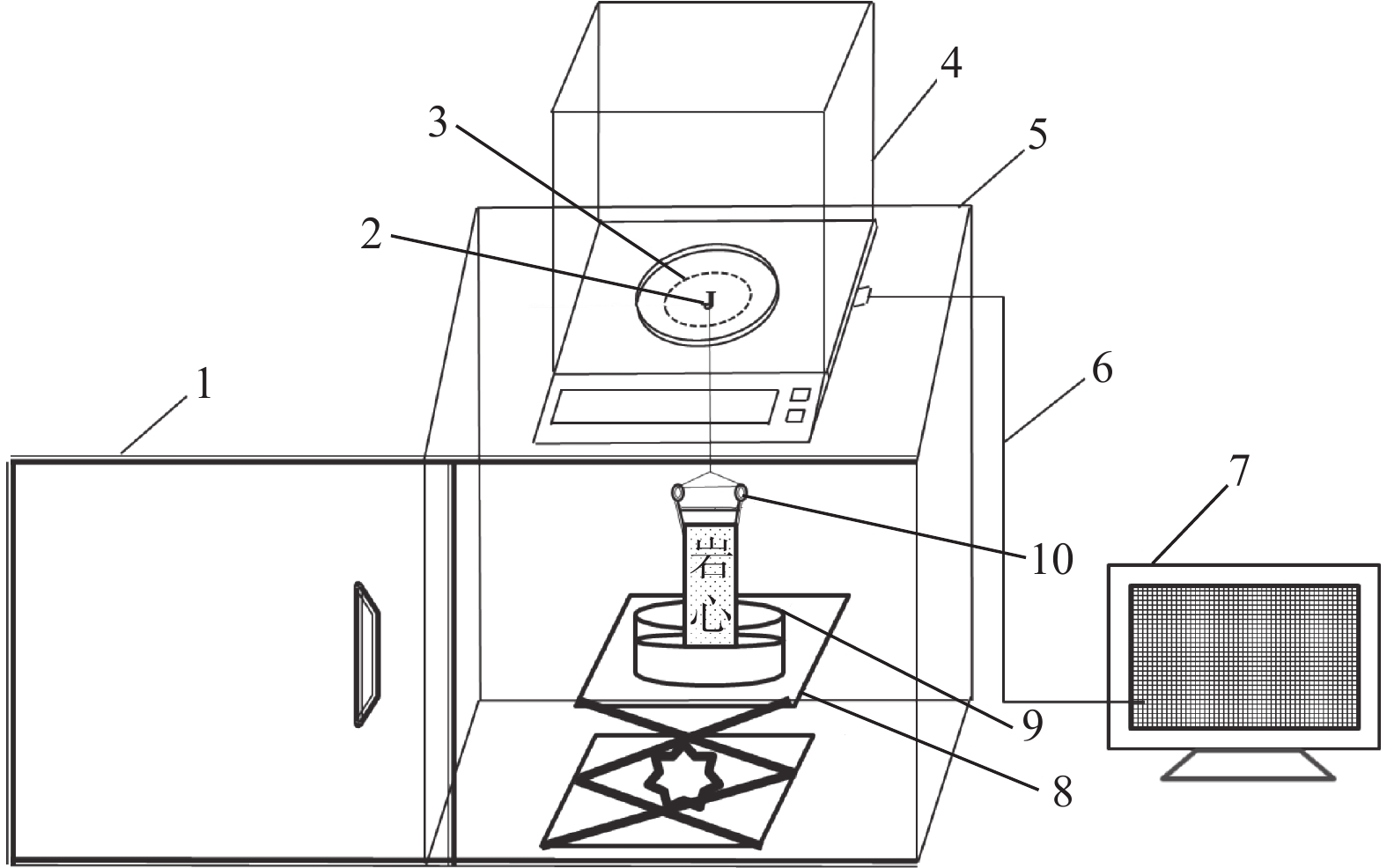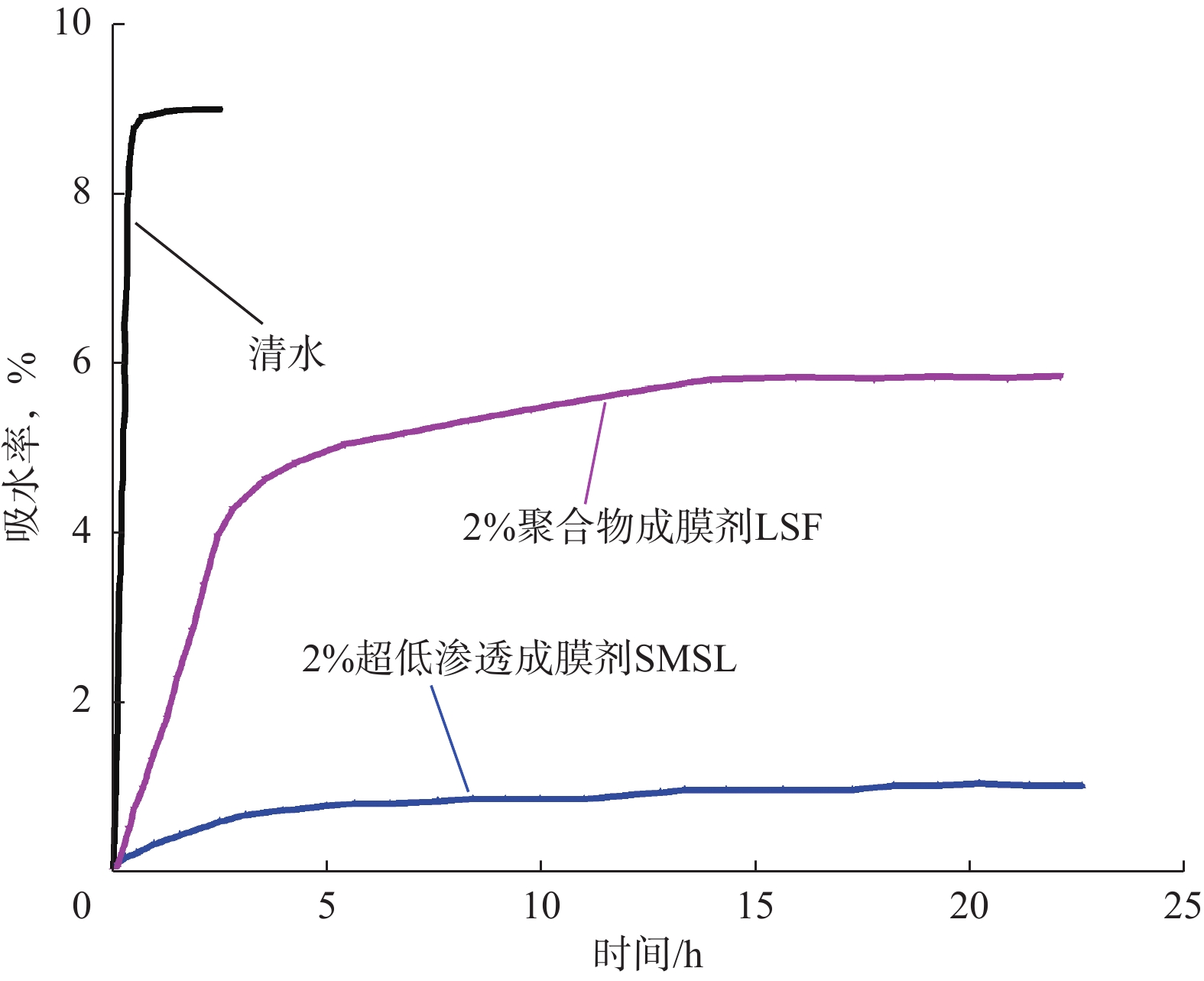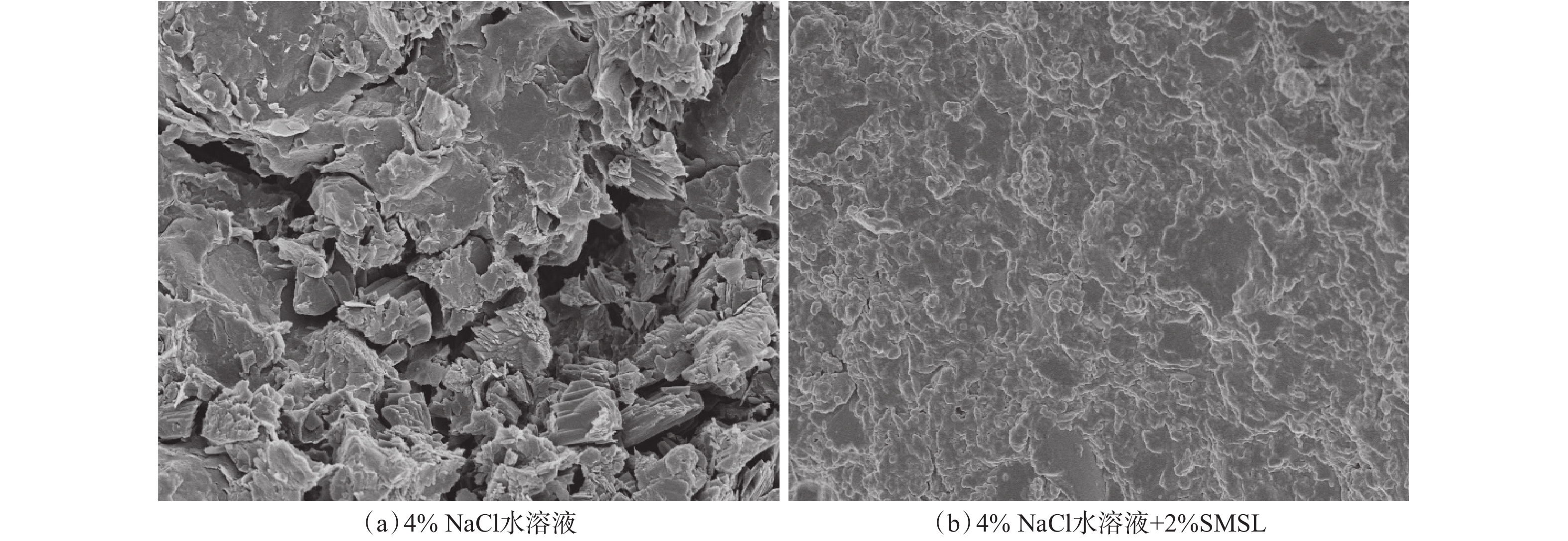Preparation and Performance Evaluations of an Ultra-low Permeability Film-Forming Agent Based on Graphene Modification
-
摘要: 为阻止钻井液滤液进入地层,维持井壁稳定、保护储层,采用改进的Hummers方法对石墨烯表面进行活化处理,引入羧基、羟基、环氧基等活性基团,与优选的单体在活化石墨烯表面接枝聚合,制备了一种基于石墨烯修饰的超低渗透成膜剂SMSL。采用红外光谱仪、元素分析仪、原子力显微镜、同步热分析仪等分析了超低渗透成膜剂SMSL的分子结构、微观形貌特征及其分散状态。采用压力传递试验、岩石自渗吸试验和电镜扫描等评价了超低渗透成膜剂SMS的致密成膜封堵特性,并评价了超低渗透成膜剂SMSL与水基钻井液的配伍性。评价结果表明,超低渗透成膜剂SMSL的分子结构达到了设计要求,可显著降低岩石的压力传递及自渗吸作用,与高效聚合物成膜剂相比其页岩成膜效率提高162.96%,致密砂岩自渗吸能力降低88.74%,与水基钻井液的配伍性较好。研究结果表明,钻井液中加入超低渗透成膜剂SMSL,可在井壁上形成致密膜,能够阻止钻井液滤液进入地层,维持井壁稳定和保护储层。Abstract: In order to prevent the drilling fluid filtrate from entering the formation, to maintain the wellbore stability and to protect the reservoir, a procedure to activate a graphene surface was conducted by using a modified Hummers method. It introduced carboxyl, hydroxyl, epoxy groups and other active groups, resulting in a kind of graphene modified film-forming agent SMSL with ultra-low permeability. It was prepared by grafting copolymerization with selected monomers on the surface of active graphene. The molecular structure, micro morphology and dispersive state of SMSL were analyzed by the infrared spectrometer, the element analyzer, the atomic force microscope and the synchronous thermal analyzer. Researchers used pressure transfer tests, core self-seepage tests and SEM to evaluate the dense film-forming plugging characteristics of SMSL and the compatibility of SMSL with the water-based drilling fluid. The results showed that the molecular structure of SMSL met the design requirements, and it could significantly reduce the pressure transfer and self-seepage effect of rocks. Specifically, the shale film-forming efficiency was 162.96% higher than that of the conventional polymer film-forming agent, the self-seepage capacity of tight sandstone was decreased by 88.74%, with very good compatibility with the water-based drilling fluid. The research indicated that when SMSL was added into the drilling fluid, a dense film can form on the wellbore to prevent the filtrate from entering the formation and thus can maintain wellbore stability and protect the reservoir.
-
Keywords:
- ultra-low permeability /
- film-forming agent /
- graphene /
- plugging /
- drilling fluid
-
我国页岩气、致密气资源量巨大,是我国天然气持续增长的两个重要支柱。根据2017年国土资源部的资源评价结果,全国页岩气可采资源量为25.4×1012 m3,致密气可采资源量为13.2×1012 m3[1-2]。页岩气、致密气等储层的渗透率极低,微裂缝、微孔隙发育,毛细自吸效应强,水进入储层易产生强烈的水化效应,影响井壁稳定,同时还易产生液相圈闭作用,导致储层渗透率降低,影响产量。因此,通常在用于超低渗透油气藏的钻井液和压裂液中加入微纳米封堵剂、成膜封堵剂等封堵材料,阻止或减缓入井流体滤液的侵入,维持井壁稳定,保护储层[3-9]。
目前,国内外钻井液、压裂液用成膜剂多以聚合物成膜剂为主,但该类成膜剂的成膜效率低,难以在近井壁附近形成超低渗封堵层,无法发挥高效成膜和封堵作用[10-11]。石墨烯具有独特的分子结构,导热性、稳定性好,比表面积大[12-14]。研究表明,加入少量石墨烯就能显著提高聚合物的化学、热学和力学等性能,并且石墨烯极薄、韧性和非渗透性强,具有能够阻止几乎所有气体和液体穿透的能力[15-17]。因此,笔者利用石墨烯的特性,通过对石墨烯表面进行活化处理,引入大量羧基、羟基、环氧基等活性基团,进而将研选的单体在活化石墨烯表面接枝聚合,制备了一种基于石墨烯修饰的超低渗透成膜剂,然后通过室内试验评价了其成膜封堵特性和有效性。
1. 超低渗透成膜剂的合成
1.1 合成原理
石墨烯分子间的作用力极强,片层间易相互堆叠,难以分离,且表面惰性强,不容易在溶剂中分散,导致其难以制成石墨烯复合材料[12-15]。笔者采用改进的Hummers方法[17-19]对石墨烯表面进行了活化处理,引入羧基、羟基、环氧基等活性基团(见图1),以增强石墨烯在水中的分散性。同时,制备的活化石墨烯片层存在大量的碳自由基(图1红色圆圈所示),反应单体可通过碳自由基和活性含氧基团在石墨烯表面发生接枝聚合反应,达到对石墨烯表面进行改性处理的目的。
根据钻井液添加剂性能要求及分子结构设计思路,石墨烯表面接枝聚合物主链应采用C―C单键结构,以提高其热稳定性;侧链的吸附、水化基团可采用羧基、磺酸基、内酰胺基团等抗温抗盐能力及刚性强的基团;同时,分子结构中应适当引入阳离子基团,可通过静电作用稳定吸附在矿物表面,减弱添加剂的高温解吸作用[20]。笔者通过正交试验选用2-丙烯酰胺基-2-甲基-丙磺酸(AMPS)、N-乙烯基吡咯烷酮(NVP)、二甲基二烯丙基氯化铵(DMDAAC)和对苯乙烯磺酸钠(SSS)等4种单体在活化石墨烯表面进行接枝聚合反应,反应式为:
1.2 活化处理
目前,石墨烯表面活化处理的方法很多,其中改进的Hummers方法因具有安全性高、活化效果好和操作简单等优点而较为常用[18-19]。在250 mL三口烧瓶中加入100 mL去离子水,在搅拌条件下依次缓慢加入15 g高锰酸钾、2 mg石墨烯、30 mL 质量分数95%的硫酸,在85 ℃下反应3 h后,缓慢滴加25 mL质量分数30%的双氧水,待混合物变为金黄色后,离心沉淀,将沉淀物用5%的氢氧化钠溶液洗涤至上部清液透明。然后将活化石墨烯溶解在去离子水中,将pH值调至8~9,采用超声波分散仪,以800 W功率超声处理30 min备用。
1.3 制备步骤
在250 mL烧杯中加入75 mL质量浓度5 mg/L的活化石墨烯溶液,依次加入18 g AMPS、10 g NVP、7 g DMDAAC和36 g SSS,搅拌至完全溶解,将pH值调至9。将反应溶液移入到500 mL的四口烧瓶中,加入0.1 g过硫酸钾,在90 ℃下反应5 h。反应产物用甲醇洗涤,除去未反应的单体及可能存在的均聚物,将反应产物置于105 ℃真空干燥器中烘干至恒重,采用超离心研磨仪将其粉碎研磨,即获得超低渗透成膜剂SMSL。
2. 超低渗透成膜剂结构表征
采用Nicolet 6700型傅里叶变换红外光谱仪测定了样品的红外光谱图,表征了其分子结构,然后采用Multimode Nano Scope IIIA型原子力显微镜观察了其微观特征、片层厚度及其在溶液中的分布形态,采用Vario EL Ⅲ型元素分析仪分析了样品的元素组成,采用SDT Q600型同步热分析仪分析了样品的热失重。
2.1 红外光谱分析
图2所示为活化石墨烯和超低渗透成膜剂SMSL的红外光谱。从图2可以看出:活化石墨烯红外光谱中的1 720 cm−1为C=O的特征吸收峰,1 070 cm−1为烷氧基和环氧基的C―O伸缩振动吸收峰,1 400 cm−1为―COOH的特征吸收峰,3 380 cm−1为羟基的伸缩振动吸收峰,1 240 cm−1为C―O―C的特征吸收峰,表明经过活化处理后石墨烯的表面存在羟基、羧基和环氧基等活性基团,很容易与水分子形成氢键,亲水性变强;超低渗透成膜剂SMSL的红外光谱除活化石墨烯的特征吸收峰外,还存在多个新的特征吸收峰,520和630 cm−1为二甲基二烯丙基氯化铵(DMDAAC)中CH2=CH―CH2R的特征吸收峰,1 040,1 155和1 195 cm−1为―SO3基的振动吸收峰,1 360 cm−1为叔胺基中C―N键的伸缩振动吸收峰,1 400 cm−1为N-乙烯基吡咯烷酮(NVP)中C―N键的振动吸收峰,1 455 cm−1为苯乙烯磺酸钠(SSS)中苯环骨架的振动吸收峰,1 506 cm−1为―NH的变形振动吸收峰,1 540 cm−1为仲酰胺基(―CONH―)中C―N键的伸缩振动吸收峰和N―H键的弯曲振动吸收峰,2 930 cm−1为―CH2―基团的伸缩振动吸收峰[21-26]。红外光谱分析表明,超低渗透成膜剂SMSL的分子结构与设计相符,实现了合成目标。
2.2 原子力显微镜分析
图3所示为活化石墨烯的原子力显微镜观察结果。从图3可以看出,活化石墨烯的横向尺寸约700~1 200 nm,片层厚度约0.42~0.85 nm,活化石墨烯呈大片层结构分布,片层薄而透明,无团聚现象存在,表明石墨烯经表面活化处理并在超声波分散的作用下,基本被剥离成单片层状结构,在水溶液中具有较好的分散性。同时,可观察到部分活化石墨烯片层明显存在弯曲褶皱现象,表明活化石墨烯片层具有较好的柔韧性。
2.3 元素分析
分析了石墨烯表面活化处理前后的元素组成,结果为:石墨烯表面活化处理前后的碳元素含量分别为95.17%和66.78%,氧元素含量分别为3.45%和22.32%,碳氧比分别为27.58和2.99。由此可知,采用改进的Hummers方法对石墨烯表面进行活化处理,可得到表面高度氧化的活化石墨烯。
2.4 热重分析
不同聚合物的热失重曲线如图4所示。由图4可知:在相同反应条件下,由AMPS、NVP、DMDAAC和SSS等4种单体反应制得的纯聚合物及不同活化石墨烯修饰的聚合物(GO/聚合物),120 ℃以下的热失重为吸附的少量水和溶剂挥发所致;纯聚合物分子链起始分解温度在225 ℃左右,随温度升高聚合物分子链迅速被破坏;经活化石墨烯修饰的聚合物,起始热分解温度显著提高,热稳定性好;用0.15%活化石墨烯修饰的聚合物,起始热分解温度提高100 ℃左右,表明用少量石墨烯修饰即可显著提高聚合物的热稳定性。
3 超低渗透成膜剂成膜封堵性评价
3.1 压力传递试验
采用自行研制的泥页岩水化–力学耦合模拟试验装置,通过压力传递试验评价成膜剂阻缓压力传递与滤液侵入的性能,计算岩石的渗透率和膜效率等关键参数,试验装置如图5所示。将岩心放入岩心夹持器,围压设定为5.0 MPa,成膜剂溶液由上游试液入口注入釜体,与岩样上端面接触,上游压力维持2.1 MPa,下游试液选用4%NaCl溶液,下游初始压力设定为1.0 MPa,通过检测下游压力变化,可获得岩心压力传递速率曲线及岩心渗透率、膜效率的变化,评价成膜剂的成膜封堵性能。
不同流体作用于四川盆地龙马溪组页岩的压力传递曲线如图6所示,表1为对应的页岩渗透率及膜效率。由图6和表1可知:NaCl溶液的压力传递速率很快,1 h左右压力即可穿透岩心,此时页岩渗透率为3.72×10−4 mD、膜效率为0.074;高效聚合物成膜剂LSF可明显降低页岩压力传递速率,压力穿透岩心时间约为9 h,此时页岩渗透率为7.56×10−5 mD,膜效率为0.108;相较于聚合物成膜剂LSF,基于石墨烯修饰的超低渗透成膜剂SMSL阻缓页岩压力传递的效果更好,压力穿透岩心时间约为15 h,此时页岩渗透率为3.02×10−5 mD,膜效率为0.284,较高效聚合物成膜剂提高了162.96%;纳米封堵剂SMNF可明显降低页岩压力传递速率,压力穿透岩心时间约12 h,此时页岩渗透率为4.86×10−5 mD,膜效率为0.167;SMSL与SMNF协同作用,基本阻隔了页岩的压力传递作用,岩心下游压力13 h后趋于稳定,基本维持在2.1 MPa左右,压力未穿透岩心,此时页岩渗透率为3.5×10−6 mD,膜效率为0.392,表明二者协同作用能更好地发挥成膜封堵作用,维持井壁稳定,保护储层。
表 1 页岩在不同流体下的渗透率和膜效率Table 1. Permeability and membrane efficiency of shale under different fluids测试流体 渗透率/10–4mD 膜效率 4%NaCl水溶液 3.720 0.074 4%NaCl + 2%LSF 0.756 0.108 4%NaCl + 2%SMNF 0.486 0.167 4%NaCl + 2%SMSL 0.302 0.284 4%NaCl + 2%SMSL + 2%SMNF 0.035 0.392 3.2 岩样自渗吸试验
采用自行研制的岩心自渗吸装置评价成膜封堵剂阻缓岩样的自渗吸能力,试验装置如图7所示。将岩心放入烘箱中,在105 ℃下烘至恒重后,在室内自然静置至恒重,测量岩心质量。将岩心放入岩心夹持器,悬挂于电子天平挂钩上。将装有测试液体的容器放在精密升降台上,调节升降旋钮使升降台缓慢上升,直至岩心下端浸入测试液体液面1~2 mm为止。关闭可动钢化玻璃板,天平归零,同时打开测试软件开始采集岩心质量,整个试验过程在恒温恒湿实验箱中进行,以确保岩心自然冷却和自吸过程中的温度和湿度相同,降低试验误差。
选取鄂尔多斯盆地延长组致密砂岩(渗透率为4.87×10−3 mD)进行岩心自渗吸试验,结果见图8。由图8可知:天然致密砂岩自吸水能力较强,2 h内就达到饱和,总吸水率高达9.24%;LSF可明显降低致密砂岩的自渗吸能力,总吸水率为5.43%;SMSL降低致密砂岩自渗吸能力的效果更为显著,初始自吸水率变化曲线较为平缓,且5 h后基本趋于稳定,总吸水率仅为1.04%,致密砂岩自渗吸能力降低88.74%,表现出了高效成膜封堵效果。
3.3 成膜特性评价
采用FEI QuANTA 200型环境扫描电子显微镜(ESEM)观测超低渗透成膜剂SMSL在API滤失试验滤饼中的存在形态,结果见图9;采用S-4800型扫描电子显微镜(SEM)观测压力传递试验后页岩封堵端面的微观形貌特征,结果见图10。由图9可知,在4%膨润土浆的API滤失滤饼中仅观察到形状不规则的黏土封堵层,在加入2%SMSL形成的滤饼中可明显观察到一层薄而透明的吸附膜。由图10可知,页岩发育大量的微孔隙、微裂缝,采用SMSL进行压力传递试验封堵后,页岩表面较为平整、密实和光滑,SMSL的表面吸附、修整功能显著提高了页岩的致密程度和膜效率,成膜封堵性能突出。
3.4 配伍性评价
将超低渗透成膜剂加入到页岩气钻井用水基钻井液中,在150 ℃下热滚16 h,测试其流变参数及高温高压(150 ℃/3.5 MPa)滤失量,评价SMSL与水基钻井液的配伍性。页岩气钻井用水基钻井液的配方为1.5%~4.0%膨润土+0.5%KOH+0~0.5%XC+ 0.5%~1.0%流性调节剂+0.2%~0.5%PAC-LV+ 2.0%~3.0%SMP-2+2.0%~3.0%SPNH+ 1.0%~2.0%聚胺+2.0%~3.0%液体乳化沥青+ 2.0%~4.0%高效润滑剂+5.0%~7.0%KCl+重晶石。
分别测试密度1.8,2.0和2.2 kg/L页岩气钻井用水基钻井液加入2%超低渗透成膜剂SMSL前后的基本性能,结果见表2。由表2可知,超低渗透成膜剂SMSL对页岩气钻井用水基钻井液流变性能的影响较小,可显著降低水基钻井液的滤失量,与其配伍性好。
表 2 钻井液性能测试结果Table 2. Test results of drilling fluid properties密度/(kg·L–1) 条件 表观黏度/(mPa·s) 塑性黏度/(mPa·s) 动切力/Pa 静切力/Pa API滤失量/mL 高温高压滤失量/mL 1.8 加入前 38.0 26.0 12.0 2.5/5.5 4.0 10.4 加入后 35.0 23.0 12.0 2.5/5.0 3.2 8.2 2.0 加入前 36.0 26.0 13.0 3.0/5.5 3.8 9.6 加入后 36.0 24.0 12.0 2.5/6.0 2.8 8.0 2.2 加入前 42.0 29.0 13.0 4.0/7.5 3.8 10.0 加入后 44.0 29.0 15.0 3.5/7.0 2.6 7.4 4. 结 论
1)采用改进的Hummers方法对石墨烯表面进行处理,制备了一种活化石墨烯。活化石墨烯氧化程度高,表面含有大量的羧基、羟基和 环氧基等活性基团,碳氧比仅为2.99。经超声分散后,活化石墨烯在水中具有较好的分散性,无团聚现象存在,横向尺寸约700~1 200 nm,片层厚度约0.42~0.85 nm。
2)2-丙烯酰胺基-2-甲基-丙磺酸、N-乙烯基吡咯烷酮、二甲基二烯丙基氯化铵和对苯乙烯磺酸钠等4种单体与活化石墨烯进行表面接枝聚合反应,制备了一种基于石墨烯修饰的超低渗透成膜剂SMSL。用0.15%石墨烯修饰,其起始热分解温度与常规聚合物相比提高100 ℃左右,说明加入少量石墨烯即可显著提高聚合物的热稳定性。
3)压力传递试验结果、岩石自渗吸试验结果、封堵层扫描电镜观察结果及配伍性试验结果表明:加入2%超低渗透成膜剂SMSL就可显著阻缓页岩压力传递及自渗吸作用,使页岩渗透率降低一个数量级,与高效聚合物成膜剂相比成膜效率提高162.96%,致密砂岩自渗吸能力降低88.74%,与页岩气钻井用水基钻井液的配伍性好。
-
表 1 页岩在不同流体下的渗透率和膜效率
Table 1 Permeability and membrane efficiency of shale under different fluids
测试流体 渗透率/10–4mD 膜效率 4%NaCl水溶液 3.720 0.074 4%NaCl + 2%LSF 0.756 0.108 4%NaCl + 2%SMNF 0.486 0.167 4%NaCl + 2%SMSL 0.302 0.284 4%NaCl + 2%SMSL + 2%SMNF 0.035 0.392 表 2 钻井液性能测试结果
Table 2 Test results of drilling fluid properties
密度/(kg·L–1) 条件 表观黏度/(mPa·s) 塑性黏度/(mPa·s) 动切力/Pa 静切力/Pa API滤失量/mL 高温高压滤失量/mL 1.8 加入前 38.0 26.0 12.0 2.5/5.5 4.0 10.4 加入后 35.0 23.0 12.0 2.5/5.0 3.2 8.2 2.0 加入前 36.0 26.0 13.0 3.0/5.5 3.8 9.6 加入后 36.0 24.0 12.0 2.5/6.0 2.8 8.0 2.2 加入前 42.0 29.0 13.0 4.0/7.5 3.8 10.0 加入后 44.0 29.0 15.0 3.5/7.0 2.6 7.4 -
[1] 位云生,贾爱林,何东博,等. 中国页岩气与致密气开发特征与开发技术异同[J]. 天然气工业,2017,37(11):43–52. WEI Yunsheng, JIA Ailin, HE Dongbo, et al. Comparative analysis of development characteristics and technologies between shale gas and tight gas in China[J]. Natural Gas Industry, 2017, 37(11): 43–52.
[2] 高树生,刘华勋,叶礼友,等. 致密砂岩气藏井网密度优化与采收率评价新方法[J]. 天然气工业,2019,39(8):58–65. GAO Shusheng, LIU Huaxun, YE Liyou, et al. A new method for well pattern density optimization and recovery factor evaluation of tight sandstone gas reservoirs[J]. Natural Gas Industry, 2019, 39(8): 58–65.
[3] 于雷,张敬辉,刘宝锋,等. 微裂缝发育泥页岩地层井壁稳定技术研究与应用[J]. 石油钻探技术,2017,45(3):27–31. YU Lei, ZHANG Jinghui, LIU Baofeng, et al. Study and application of borehole stabilization technology in shale strata containing micro-fractures[J]. Petroleum Drilling Techniques, 2017, 45(3): 27–31.
[4] 侯杰. 硬脆性泥页岩微米-纳米级裂缝封堵评价新方法[J]. 石油钻探技术,2017,45(3):32–37. HOU Jie. A new method of plugging micro/Nano meter cracks in hard, brittle shale[J]. Petroleum Drilling Techniques, 2017, 45(3): 32–37.
[5] 路保平,丁士东,何龙,等. 低渗透油气藏高效开发钻完井技术研究主要进展[J]. 石油钻探技术,2019,47(1):1–7. LU Baoping, DING Shidong, HE Long, et al. Key achievement of drilling & completion technologies for the efficient development of low permeability oil and gas reservoirs[J]. Petroleum Drilling Techniques, 2019, 47(1): 1–7.
[6] 董兵强,邱正松,陆朝晖,等. 临兴区块致密砂岩气储层损害机理及钻井液优化[J]. 钻井液与完井液,2018,35(6):65–70. DONG Bingqiang, QIU Zhengsong, LU Zhaohui, et al. Damage mechanisms determination for tight sands gas reservoir in Block Linxing and drill-in fluid optimization for protection of the reservoir[J]. Drilling Fluid & Completion Fluid, 2018, 35(6): 65–70.
[7] 朱杰,熊汉桥,吴若宁,等. 裂缝性气藏成膜堵气钻井液体系室内评价研究[J]. 石油钻采工艺,2019,41(2):147–151. ZHU Jie, XIONG Hanqiao, WU Ruoning, et al. Laboratory research of sealing and gas-plugging drilling fluid system in fractured gas reservoir[J]. Oil Drilling & Production Technology, 2019, 41(2): 147–151.
[8] 林永学,王伟吉,金军斌. 顺北油气田鹰1井超深井段钻井液关键技术[J]. 石油钻探技术,2019,47(3):113–120. LIN Yongxue, WANG Weiji, JIN Junbin. Key drilling fluid technology in the ultra deep section of Well Ying-1 in the Shunbei Oil and Gas Field [J]. Petroleum Drilling Techniques, 2019, 47(3): 113–120.
[9] 王伟吉,邱正松,暴丹,等. 温压成膜封堵技术研究及应用[J]. 特种油气藏,2015,22(1):144–147. WANG Weiji, QIU Zhengsong, BAO Dan, et al. Warm-compaction film-forming plugging and its application[J]. Special Oil & Gas Reservoirs, 2015, 22(1): 144–147.
[10] 蒋官澄,毛蕴才,周宝义,等. 暂堵型保护油气层钻井液技术研究进展与发展趋势[J]. 钻井液与完井液,2018,35(2):1–16. JIANG Guancheng, MAO Yuncai, ZHOU Baoyi, et al. Progress made and trend of development in studying on reservoir protection drilling fluids[J]. Drilling Fluid & Completion Fluid, 2018, 35(2): 1–16.
[11] 张汝生,王增宝,赵梦云,等. 助破胶胶囊型压裂屏蔽暂堵保护剂的制备与性能评价[J]. 油田化学,2019,36(2):225–229. ZHANG Rusheng, WANG Zengbao, ZHAO Mengyun, et al. Preparation and performance evaluation of helper-breaking capsule type shielding temporary plugging protection agent in fracturing[J]. Oilfield Chemistry, 2019, 36(2): 225–229.
[12] 樊玮,张超,刘天西. 石墨烯/聚合物复合材料的研究进展[J]. 复合材料学报,2013,30(1):14–21. FAN Wei, ZHANG Chao, LIU Tianxi. Recent progress in graphene/polymer composites[J]. Acta Materiae Compositae Sinica, 2013, 30(1): 14–21.
[13] 许明路,何小芳,贺超峰,等. 石墨烯/聚合物复合材料的研究进展[J]. 塑料工业,2016,44(2):27–33. XU Minglu, HE Xiaofang, HE Chaofeng, et al. Research progress in graphene/polymer composites[J]. China Plastics Industry, 2016, 44(2): 27–33.
[14] 耿黎东,王敏生,蒋海军,等. 石墨烯在石油工程中的应用现状与发展建议[J]. 石油钻探技术,2019,47(5):80–85. GENG Lidong, WANG Minsheng, JIANG Haijun, et al. The status of the development of graphene applications in petroleum engineering[J]. Petroleum Drilling Techniques, 2019, 47(5): 80–85.
[15] WANG Han, XIE Guiyuan, YING Zhe, et al. Enhanced mechanical properties of multi-layer graphene filled poly(vinyl chloride) composite films[J]. Journal of Materials Science & Technology, 2015, 31(4): 340–344.
[16] JAN R, HABIB A, ABBASSI H, et al. Dielectric spectroscopy of high aspect ratio graphene-polyurethane nanocomposites[J]. Electronic Materials Letters, 2015, 11(2): 225–231. doi: 10.1007/s13391-014-4265-5
[17] HUMMERS W S Jr, OFFEMAN R E. Preparation of graphitic oxide[J]. Journal of American Chemical Society, 1958, 80(6): 1339. doi: 10.1021/ja01539a017
[18] LEE K Y, BYEON H H, JANG C, et al. Hydrodynamic assembly of conductive nanomesh of single-walled Carbon nanotubes using biological glue[J]. Advanced Materials, 2015, 27(5): 922–928. doi: 10.1002/adma.201404483
[19] 尹俊强,张伟超. 石墨烯纳米片/聚乙烯复合薄膜电磁干扰屏蔽[J]. 复合材料学报,2019,36(2):293–303. YIN Junqiang, ZHANG Weichao. Electromagnetic interference shielding performance of graphene/nanosheetpolyethylene composite films[J]. Acta Materiae Compositae Sinica, 2019, 36(2): 293–303.
[20] 王中华. 超高温钻井液体系研究(Ⅰ):抗高温钻井液处理剂设计思路[J]. 石油钻探技术,2009,37(3):1–7. WANG Zhonghua. Studies on ultra-high-temperature drilling fluid system (1): design Ultra-High-Temperature drilling fluid additives[J]. Petroleum Drilling Techniques, 2009, 37(3): 1–7.
[21] COLEMAN J N. Liquid exfoliation of defect-free graphene[J]. Accounts of Chemical Research, 2013, 46(1): 14–22. doi: 10.1021/ar300009f
[22] KUMARI S, PANIGRAHI A, SINGH S K, et al. Enhanced corrosion resistance and mechanical properties of nanostructured graphene-polymer composite coating on Copper by electrophoretic deposition[J]. Journal of Coatings Technology Research, 2018, 15(3): 583–592. doi: 10.1007/s11998-017-0001-z
[23] NOH M J, OH M J, CHOI J H, et al. Layer-by-layer assembled multilayers of charged polyurethane and graphene oxide platelets for flexible and stretchable gas barrier films[J]. Soft Matter, 2018, 14(32): 6708–6715. doi: 10.1039/C8SM00706C
[24] VUCAJ N, QUINN M J, BAECHLER C, et al. Vapor phase synthesis of conducting polymer nanocomposites incorporating 2D nanoparticles[J]. Chemistry of Materials, 2014, 26(14): 4207–4213. doi: 10.1021/cm5014653
[25] BOLAND C S, KHAN U, RYAN G, et al. Sensitive electromechanical sensors using viscoelastic graphene-polymer nanocomposites[J]. Science, 2016, 354(6317): 1257–1260. doi: 10.1126/science.aag2879
[26] DIVIGALPITIYA R, BAULD R, BAZYLEWSKI P, et al. Thermo-optical characterization and thermal properties of graphene-polymer composites: a review[J]. Journal of Materials Chemistry C, 2018, 6(12): 2901–2914. doi: 10.1039/C7TC01719G
-
期刊类型引用(3)
1. 张鸿鹄. 油基钻井液用氮杂石墨烯的研制与应用. 钻井液与完井液. 2024(03): 279-287 .  百度学术
百度学术
2. Jinsheng Sun,Yuanwei Sun,Yong Lai,Li Li,Gang Yang,Kaihe Lv,Taifeng Zhang,Xianfa Zhang,Zonglun Wang,Zhe Xu,Zhiwen Dai,Jingping Liu. Progress in the application of graphene material in oilfield chemistry:A review. Petroleum. 2024(02): 175-190 .  必应学术
必应学术
3. 田增艳,杨贺卫,李晓涵,尹丽,王信,黄臣. 大港油田页岩油水平井钻井液技术. 石油钻探技术. 2021(04): 59-65 .  本站查看
本站查看
其他类型引用(4)



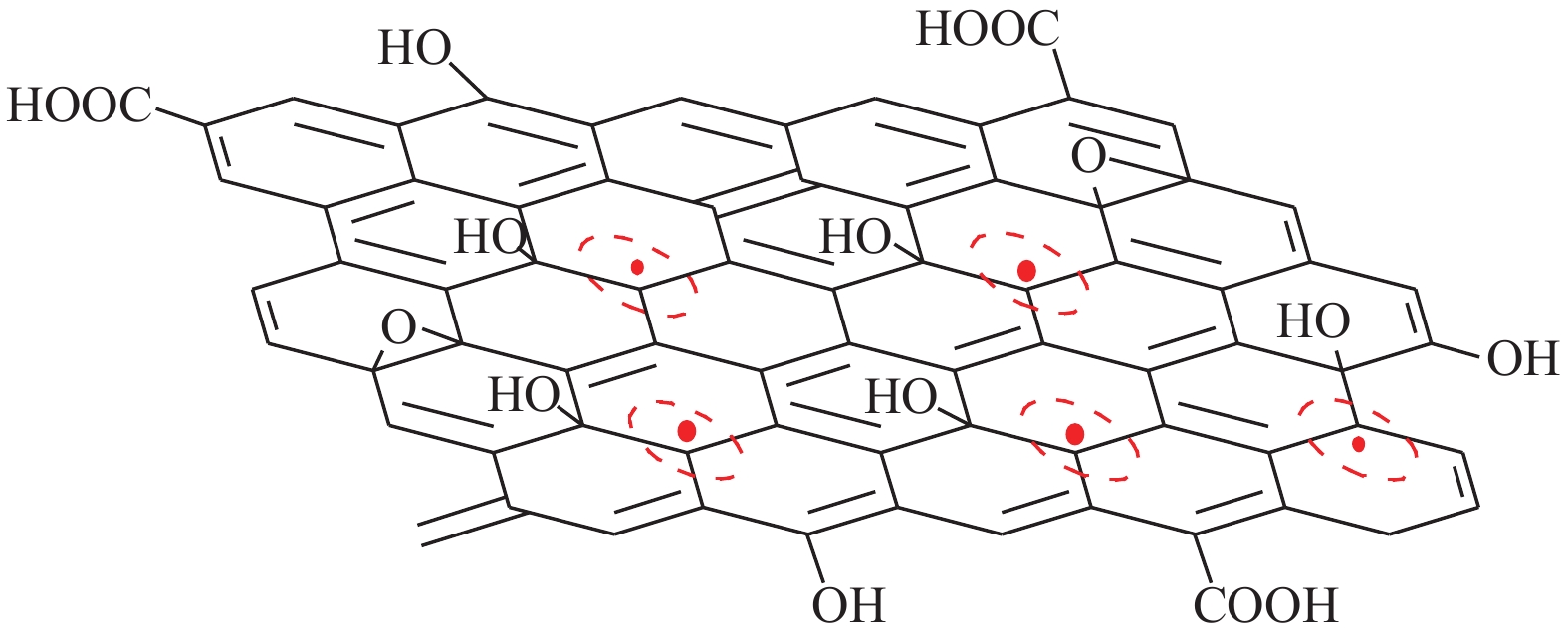
 下载:
下载:

